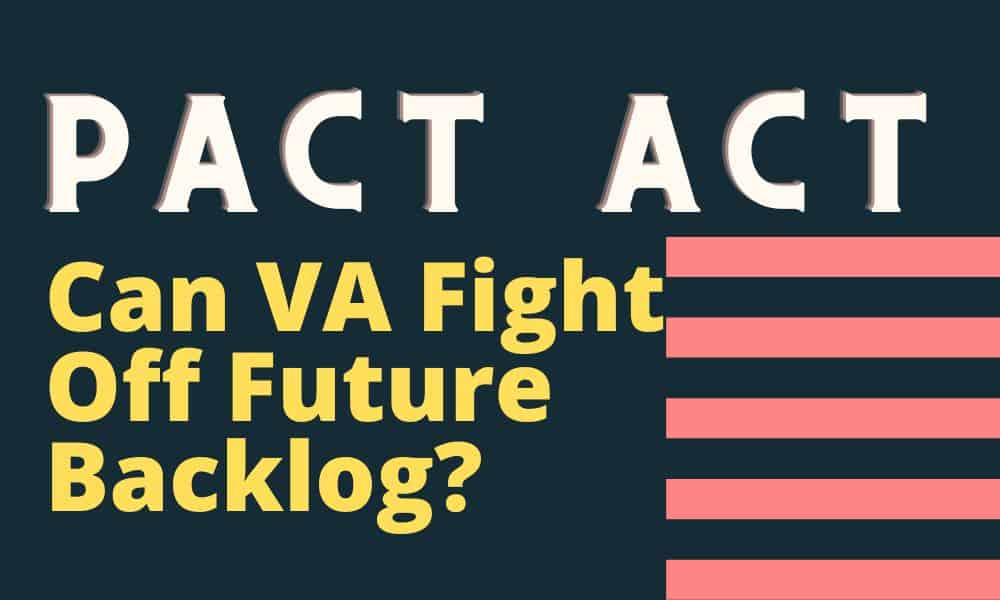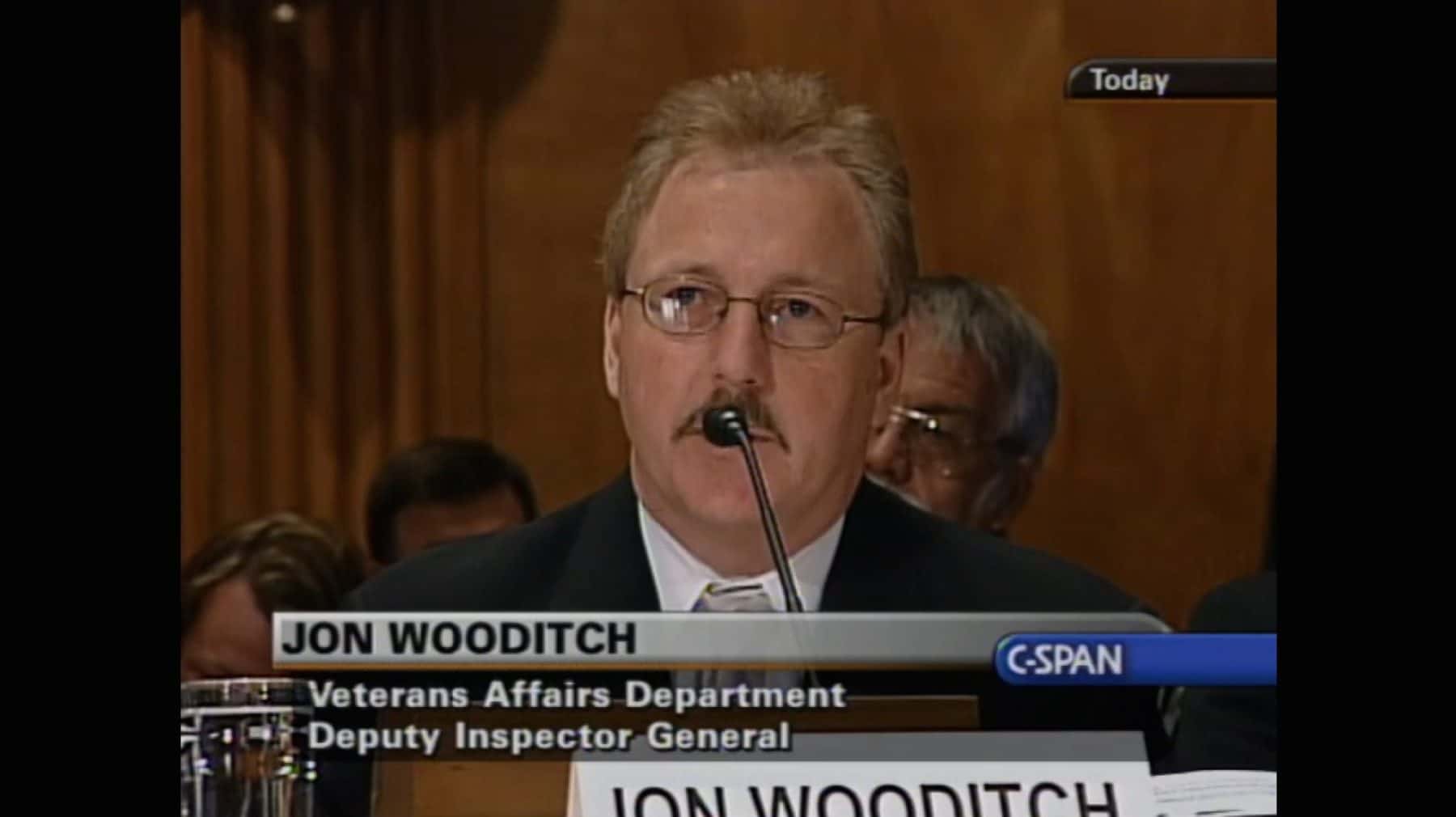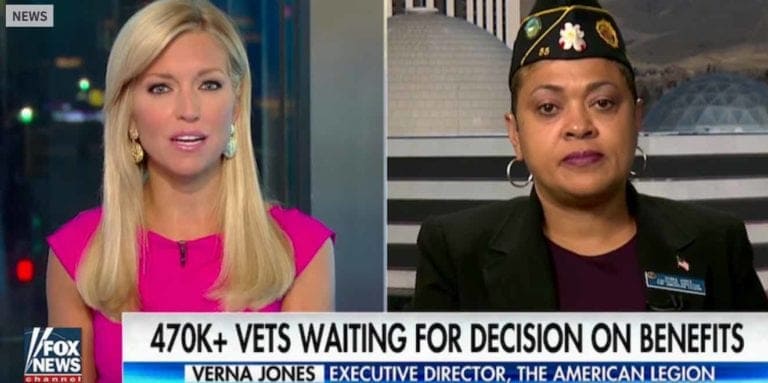PACT Act: Can VA Fight Off Future Backlog?
With the PACT Act, VA will see an unprecedented influx of new claims from veterans previously denied. How many? The agency estimates 3.5 million veterans may be eligible for new benefits.
Back in 2011, VA created a huge backlog and spent the better part of the Obama and Trump administrations sorting out. That backlog was created with the influx of up to 250,000 new Vietnam veteran claims following law changes to various presumptive conditions.
VA was ill equipped and too understaffed to handle the workload, and the agency’s backlog served as fodder at Congress to justify significantly boost its funding for IT systems, the paperless claims system, and other efforts. Some worked and some did not.
In the end, VA and VSOs worked together on a few remedies that resulted in veterans surrendering certain due process and procedural rights to help VA do its job. It also cost taxpayers in IT fixes and other remedies. Some worked. Some flopped.
But, were veterans’ sacrifices of their rights worth it?
Claims are processed more quickly a decade later, but the rights of veterans for remedies after a bad decision are more restrictive.
Claims Backlog Fixes
To fix that backlog, the regional office backlog, veterans lost certain rights including the right to submit a claim on regular paper. VA fought for and won the ability to dictate to veterans how they can submit claims. It created a rigid and confusing claims process that somewhat limited the agency’s obligations to help veterans. Veterans must now use certain forms jammed with legal-ease with specified requirements.
RELATED: Massive Claims Backlog At St. Petersburg RO
The use of mandatory forms and transition to fully paperless claims files did not fully fix that backlog, so VA and its VSO partners worked through the Appeals Modernization Act, or AMA for short. What was once a rather straightforward process to appeal a bad claim morphed into a legal mess. That mess included even more form requirements requiring a degree of legal understanding to pursue without representation for many veterans.
RELATED: VA Pays Bonuses Despite Backlog Slip-up
More legal-ease, more dependency on others for representation. VA scored a bigger budget to buy more expensive IT systems and more money for additional personnel.
RELATED: VBMS Backlog Fix Cost Taxpayers $1 Billion
Despite those changes and erosion of rights to help VA do its job, many of those claims in the backlog at the regional office level have been pushed to the Board of Veterans Appeals where a new backlog has been created.
The Board cannot process appeals fast enough, and it cannot hire enough attorneys despite record budgets. Appeals are still taking a long time meaning veterans are not getting timely relief.
RELATED: Tampa Billboard Exposes Backlog Bamboozle
And now, we see a new set of criteria signed into law by the President. I am thrilled with the new legislation.
I am also wary and wondering what other rights the agency will force veterans to abandon to help it timely process the mountain of claims that are just over the horizon.
While the press has covered the PACT Act largely in the context of burn pit toxic exposure, the new legal framework includes a list of exposures:
- Radiation exposure from cleanup of Enewetak Attoll
- Nuclear response near Palomares, Spain, or Thule, Greenland
- Herbicide exposure
- Burn pit and other toxins
This covers a lot of ground. Is VA up for the challenge?
VA All But Admits Future Backlog
At the national DAV convention last week, the Acting Undersecretary for Benefits Josh Jacobs confirmed concerns about potential backlog issues.
“We will likely see challenges with timeliness because of just the sheer size and volume. … The timeline is still working through the calculations, but I think it’s probably going to take several years for us to try to get back to normal once we expect all these claims coming in,” Jacobs said.
“With the additional veterans now finally being recognized for their service, it may take us some time to get to get through all those claims,” McDonough told GovCIO Media & Research.
VA plans to increase its workforce systems and automation for claims processing. Secretary Denis McDonough noted its claims automation has seen major successes and cut processing times in some cases.
“We shouldn’t have to require [veterans] to go fill out additional paperwork, bring those papers in, we shouldn’t have to go through big piles of paper, piece by piece. We should let the machines do that. Make sure that machines do well what they do, and then humans do well what humans do,” McDonough said. “Those are the three things we’ve done: hired people, we’ve improved the process itself, and we’re automating the process.”
For the past decade, VA has boasted about its silver bullet of going digital where the veteran’s claims file is no longer paper but digital. My point in bringing that up here is some curiosity as to why VA is still talking about going away from paper… since all claims submitted are either digitally submitted or digitized shortly after receipt of a paper document.
The GovCIO article highlighted how automate projects resulted in some increases in timeliness of processing. This suggests there are automation projects that are unsuccessful or untimely, perhaps. I wonder how VA addresses the claims caught up in bad projects.
Presumptive Disabilities Covered
Anyway, VA.gov lists these cancers and illnesses as being added due the PACT Act. Note, for Gulf War veterans, sinusitis, rhinitis, asthma, and sleep apnea (if classified as a sleep disturbance) are already considered presumptive conditions.
Presumptive Cancers
These types of cancers are now considered presumptive:
- Brain cancer
- Gastrointestinal cancer of any type
- Glioblastoma
- Head cancer of any type
- Kidney cancer
- Lymphatic cancer of any type
- Lymphoma of any type
- Melanoma
- Neck cancer
- Pancreatic cancer
- Reproductive cancer of any type
- Respiratory (breathing-related) cancer of any type
Presumptive Illnesses
These illnesses are now considered presumptive:
- Asthma that was diagnosed after service
- Chronic bronchitis
- Chronic obstructive pulmonary disease (COPD)
- Chronic rhinitis
- Chronic sinusitis
- Constrictive bronchiolitis or obliterative bronchiolitis
- Emphysema
- Granulomatous disease
- Interstitial lung disease (ILD)
- Pleuritis
- Pulmonary fibrosis
- Sarcoidosis
How do you know?
There are two sets of criteria veterans fall under where the presumptive conditions are applicable for burn pit exposure.
Post-9/11 Locations
If you served on or after September 11, 2001, in any of these locations, the presumptive likely applies to you:
- Afghanistan
- Djibouti
- Egypt
- Jordan
- Lebanon
- Syria
- Uzbekistan
- Yemen
- The airspace above any of these locations
Gulf War Locations
If you served on or after August 2, 1990, in any of these locations, you are likely considered presumptively exposed to burn pits or other toxin exposures:
- Bahrain
- Iraq
- Kuwait
- Oman
- Qatar
- Saudi Arabia
- Somalia
- The United Arab Emirates (UAE)
- The airspace above any of these locations
Anticipation
A large number of veteran groups were fighting to push the legislation through. What do you think of it and what could go wrong? We all anticipate changes and a future backlog of some kind.
In 2011, Vietnam veterans were granted various presumptive conditions impacting 250,000 veterans for a few billion dollars in benefits. All veterans, not just Vietnam veterans, were then nailed with an incredible claims backlog for years. Various regional offices issued a record number of claims decisions, many of which were not adjudicated correctly.
Now, we have a huge appeals backlog addressing the large number of bad decisions that is bogging down the Board of Veterans Appeals.
The new legislation, once implemented, covers much more ground than in 2011. Think 250,000 compared to 3.5 million. Think a budget of $4 billion compared to a budget of $400 billion. The difference is astonishing.
What are some differences?
Veterans surrendered a significant amount of rights to help VA do its job. The agency now requires forms for claims and appeals. Veterans lost certain due process rights. The appeals process is supposedly more streamlined but yet more confusing. The agency implemented the electronic claims file.
It sure is interesting to hear McDonough and friends starting to talk up the problem of paper processing when paper anything should no longer be a variable slowing the agency down.
VA no longer processes the intake of paper, a government contractor does it at the Evidence Intake Center. Where we go from here should be very interesting, indeed.
UPDATE: 8/16/2022: Information about existing Gulf War presumptive conditions for respiratory was updated.





Say wouldn’t it be nice if the Secretary of Veterans Affairs and other admins at VA were actually elected positions instead of these positions being appointed every four years by some politician from a right wing party??? An appointed position that he or she is guaranteed to loose eventually no matter how good or bad they do the job? What kind of incentive is this? (Makes about as much sense as the electoral college system in presidential elections. One candidate can get more votes and still loose the election. So when you vote for president, you are really voting for the CHANCE to elect a president more than anything.) Another thing about VA is no transparency and the fact that employees have to kill someone to get fired. Failure built into this system at every level….cherry on top of the cake is that they are cheap! If you need your blood taken or you are dying then ok but everything else forget about it 😆
Hi everyone, I have been actively trying to address requiring the VA to offer Lung cancer screening to Veterans exposed to known respiratory carcinogens for over five years now. I sent my below post to the Go2 Foundation and once again asked what the GO2 Foundation has done to promote Lung cancer screening for Vets, based on their exposures, with the VA and Congress?
The Go2 Foundations Angela Criswell’s response posted below, was predictable, and we have had similar email dialogues in recent years. Veterans have asked the VA for LDCT screening based on their exposures to Agent Orange and were denied. A/O and Burn pit registry exams do not include lung cancer screening with Low dose CT . The Go2 Foundation is a VA Pals partner, utilizes Veterans and tells their stories for purposes of fundraising, and according to Angela, they are still trying to identify pathways to promote lung cancer screening for Veterans with the VA?
The Go2 Foundation appears to be just another broken cog in the VA (and congress) wheel to deny Veterans life saving screenings . Per the GO2 Foundation :”The GO2 Foundation is dedicated to saving, extending & improving the lives of those vulnerable, at risk & diagnosed with lung cancer.” See Go2 email reply below.
Chicago Mike
Hi Mike: It is good to hear from you! I appreciate your comments on the diabledveterans.org article addressing the PACT Act, as well as on GO2 Foundation’s recent blog post.
We recognize that the PACT Act’s passage is a first step in building access to early detection opportunities for Veterans with toxic exposures. You correctly point out that the PACT Act focuses benefits and services on those who are post-diagnosis, and so there is lack of clarity about how this will also contribute to early detection access for those at risk for lung cancer. In one of the overview documents that the VA released (see attached, page 3, top left column) under the heading “What is a toxic exposure screening? How will it help Veterans?” they note that as part of their periodic toxic exposures screenings where they ask Veterans about potential exposures, “[this] will help VA health care providers individualize health care services to improve health outcomes and patient experience.” (emphasis original)
To my thinking, LDCT lung cancer screening must be part of the “individualized health care to improve health outcomes” received by every veteran with toxic exposures. We are currently identifying the best pathways for raising this issue with VA leadership as part of their PACT Act implementation plan, and will be advocating as well that the VA include this as part of their health promotion and Lung Cancer Precision Oncology Program strategies and activities.
I am glad you reached out to us again!
Best Wishes,
Angela
cid:[email protected]
Angela Criswell, MA, CPS
Director, Quality Screening and Program Initiatives
[email protected]
go2foundation.org
Yes! That is precisely what the tax-money-laundering pork factory intended! Every congressional office is another for-profit enterprise. Hey, it works! For them! All they care about is that their armies of followers vote for them to get back to the profiteering.
Now, add in the Charlie Foxtrot that is Cerner. I found my old HyHealtheVet to be an profoundly useful tool. It puts on written/recorded record what is often ignored by voice-comms. Now, I am completely locked out. “Oh, ya, we’re having a problem with that”. I go into my local CBOC, ” Oh, ya, we’re having a problem with that.” I’m in the vaunted Roseburg system. They’ve gone to Cerner hell. I’m also being treated by VA in Portland Specialty. It took six weeks for my doc in PDX to get orders sent to my CBOC via Roseburg – for walk-in lab work.
The flood of new claims and medical needs that PACT will create, in the midst of the Cerner-feed will not be pretty. Still, in spite of earned sketicism, the PACT will help some guys get what they need and deserve. Perhaps naive, but a little optimism on their behalf won’t hurt.
Yes, for the younger veterans there will unfortunately be a huge backlog. This is due to no critical thinking on the part of senior leadership at the VA. You see – – – none of the senior VA leadership seemed to be aware that we just disengaged from the longest-running conflict in the history of our nation.
While they did not know how long the war would last after 911 – – – they did know that a whole bunch of your folks would be coming home needing various services from them. What did they do? I don’t know, but I do know that what they did not do was to properly plan for the influx. They have yet to do that just once in their history. And in this latest conflict – – – they have only had 20 years to get it done.
I am glad that they passed the PACT act for you younger veterans. Never enough, but every little bit helps.
Just remember though that when it comes to the VA, it is mostly Sierra Squared Delta Squared.
God bless and good luck to you!
JC, I have to believe that “they” knew there’d be a massive influx. Hell, Darth Cheney said something to the effect that we’d be there for 100 years. They knew that modern battlefield medical response would save more lives than in prior theaters of battle, e.g more survivors needing long term care. I’m sure the critical thinkers are there, both at DoD and the VA. It’s just those darn gubmint issued gag-balls that get in the way of proper communication.
Hang a big Roger on that one!
I actually remember Liz’s daddy saying that. Old but not senile. You are most probably correct. Some critical thinkers do exist within the VA. You’d never know it though by the way they treat every bit of information as if it were Critical Nuclear Weapon Design Information.
Shit! They act is if my blood pressure readings are Top Secret. Shouldn’t I have a right to my own BP readings when I ask? Good thing I have a Sphygmomanometer at my house and know how to properly use it.
To be fair, the docs and nurses that I see are cool for the most part. Maybe I have been lucky. But the scheduling clerks, and the personnel at the call centers need some serious training on proper communication. Because they just cannot seem to provide it.
VA reminds me of the old adage Proper Prior Planning Prevents Pyss Poor Performance. Veterans routinely see the last three P’s from the VA. When will veterans start seeing the first three?
Good to see you are still alive! Hope you are doing well.
JC. That’s why I am so bummed about not being able to get back into my records via he new Cerner system. I’d always be able to look at test results before the VA specials or PCPs would get back to me. Fortunately I still have access to the stuff out of Portland which is where I spend most of my medical curiosity lately. I hope the get the Cerner bugs worked out before they try to switch over to a bigger system.
“They act is if my blood pressure readings are Top Secret. Shouldn’t I have a right to my own BP readings when I ask?”
In my experience, BP readings are something we have to insist on hearing out loud because the tendency has been for my nurses to enter lower, false readings in the record.
The VA is like a grocery store with plenty of employees yet you walk in and there is nothing on the shelf. I know a guy with serious pain issues who needs ( disk replacement) surgery yet they will not do it. This individual can barely do a damn thing and lives a misrable life. Another guy had similar problems, purple heart recipient mind you, and they made him wait 6 years to do the surgery just for the hell of it. They don’t want to pay for anything but employees that will tell you that you are fked and they won’t help. This is complete fraud and nobody gives a flying fk. Also veteran suicides they pretend to care about on television but in reality they don’t bat an eye when vets are killed or jailed. They use psychology theories to blame it on the veteran and continue to collect a check. Also civil rights violations out the ying yang at VA’s throughout the south.
Ding! Ding! Ding!
Olmstead v L.C.
Different care for different classes of people.
Outside the VA, pituitary damage is looked for, diagnosed, treated. Inside the VA, Fluoride!
I was referred to an outside hospital in 2018 by the VA and I initially did not appreciate one female doctor sneaking an instrument to shove up my rectum without informing what she wanted to do and give me the medical reason for the exam which I personally as a former RN would have understood and accepted.
I had to correct the male doctor about my x-ray of my entire back and not just my lower back.
Finally, I was asked for the name of an outside pharmacy where I would have to pick up my medications prescribed which I found unusual and a surprise. I agree that we the vets should be given the opportunity to be referred to outside or private hospitals or clinics.
Ben,
Despite Somalia being listed for several years as eligible for the Burn Pit Registry, it is NOT! I have tried for years to get recognized for my deployment from Aug ’93 to Feb ’94. no matter whom I speak with or how often I check the VA website. it tells me I am NOT covered. This is a travesty that needs corrected. I suffer from Chronic sinusitis which I am already service connected, however we all fear past, current and future as yet diagnosed illnesses or cancers related to our exposures will manifest and then have to fight for service connection for treatment. I implore you to work to get the VA intake systems updated to reflect what is covered in the PACT act so those of us who served in Somalia can be added to these registries.
The Pact Act does not address detection of Lung Cancer in the early stages of the disease when it is curable. Many Veterans will continue to die from Lung Cancer despite the passage of the PACT Act which was officially named after Sgt. 1st Class Heath Robinson who died from Stage 4 Lung Cancer.
VA Secretaries, Shulkin and Wilke both recognized in national press releases, that Veterans are at a higher risk for lung cancer due to their military exposure to known respiratory carcinogens.
These press releases announced the VA’s “Partnership to Increase Access to Lung Screening” (PALS) with the Lung Cancer Alliance nka The Go2 Foundation for Lung Cancer. (The American Lung Association is also a PALS Partner).
Per the CDC: “”The only recommended screening test for lung cancer is low-dose computed tomography (also called a low-dose CT scan, or LDCT).”
Per an Article from the University of Chicago: “The cure rate for patients diagnosed with stage one lung cancer is more than 70 percent”.
Some VA facilities offer Low Dose CT to Veterans who smoked cigarettes but do not offer LDCT due to Veterans exposures. X-rays will only show Lung Cancer in the later stages of the disease when treatments are limited.
Per the Mayo Clinic: “Lung cancer typically doesn’t cause signs and symptoms in its earliest stages. Signs and symptoms of lung cancer typically occur when the disease is advanced.”
Per “radiologyinfo.org”: “LDCT scans of the chest produce images of high enough quality to detect many abnormalities while using up to 90 percent less ionizing radiation than a conventional chest CT scan.”
With regards to Lung cancer, the Pact Act will compensate Veterans, only after they receive a diagnosis which is usually a death sentence.
The VA and Congress are aware of this. “C’mon Man”
Chicago Mike
Fine letter, thank you, Chicago Mike. Congress legislates with the major view toward caring for their paymasters; the lobbyists who deliver the most mullah get the most say on what goes into the legislation. Congress has reduced itself to a tax-dollar laundering racket.
Little did we know when we were patriots they, more often than any of them will admit, agreed with H Kissinger: combat veterans are a garbage disposal problem. When he was more diplomatic, he said things like this:
“Military men are just dumb, stupid animals to be used as pawns in foreign policy.”
That quote came from here:
https://www.goodreads.com/quotes/218473-military-men-are-just-dumb-stupid-animals-to-be-used
Eliminate VHA but keep VBA. Give Veterans an insurance card and let them go where they please. The bums at VHA can then get a job in the “free market” and vets can choose wether to see them or not. At VHA, if they are a crumb bum, you have no other choice but to see them. Telling people that they have “free healthcare” and then subjecting them to some of these bums is a crime against humanity. It must end.
It is charming observing from the outer provinces the net results of the Congressional Swamp’s ever-self-praised passing of any funding (for whatever). Follow the money. My bet is the above report is indicating in more ways than one might readily notice, what is more pork, both further enriching existing billionaires, and manufacturing newer ones. My bet is also that the sketch above initiates the illustration of how any legislation the bipartisan consensus swamp dwellers pass results in confirmation of Plato’s contention about legislation creating many times more problems than it supposedly addresses.
We must face up to some unwelcome reality here: the empire is imploding; VA is but a shadow of the massive wasteland called DoD, DoS, DHS, et. al. All of our bureaucracies are now industry captives. VA, for example, is beholden to Big PhRma, Inc., Big Hospital, Inc., Big Medical Equipment, Inc. etc. We “cannon fodder” get ever more “catch-22” nonsense, and ever less actual care from VA. The reason is simple. VA’s primary clientele is that batch of Congress members who routinely assure they get the pork “for their district” into any and every piece of VA funding legislation. Like the POTUS GWB said of “his constituency” being the Wall Street moguls, every member of Congress know who fattens their respective campaign war chest. Until we muster the troops to elect to Congress representatives who want to shrink the swamp instead of expanding it with more regime-change-forever wars, we get more regulation, and less of anything decent.
You’re right….”follow the money”.
“Backlog” is prep speak for the hiring of x-teen hundred thousand new loyal gov’t employees to serve as trolls to the exploited Veteran community.
VHA takes on aspects of the economic and political system that encapsulates it. In other words, they treat it like a capitalist system mean to generate profits complete with internal corporate like structure. However, the damn place doesn’t generate profits! It’s a social healthcare system only semi functioning because of constant concerns with saving and the downward pressure that results. Competition is also an aspect in a capitalist system. With many veterans having no alternative to VA they will compete against the Veteran! Completely rediculous. Also you can’t have fiscally conservative people running such a system or it’s not gonna function properly.
Yes! Joe Corsin, that is precisely what the congressional tax-money-laundering pork factory intended! Every congressional office is another for-profit enterprise. Hey, it works! For them! All they care about is that their armies of followers vote for them to get back to the profiteering.